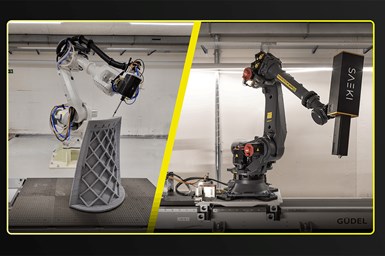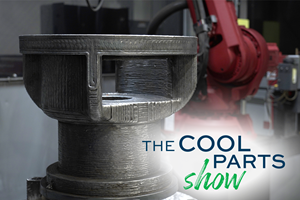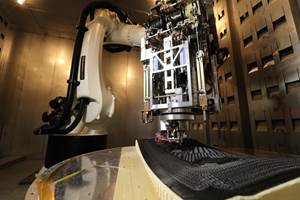Saeki Robots Manufacture Large Parts for Lights-Out Production
Saeki says it is building flexible factories of the future by leveraging digital manufacturing and robotics, providing an end-to-end automation solution in 24 hours with manufacturing large parts performed by robots.
Robotic digital manufacturing includes 3D printing, machining, postprocessing and part inspection with one robot, fully automated. Photo Credit: Saeki
Saeki is offering robots-as-a-service for the manufacturing industry, enabling flexible lights-out factories of the future by leveraging digital manufacturing and robotics. The company provides end-to-end automation for 3D printing, machining and inspecting functional large parts, delivered next day.
It is said the architecture, engineering and construction industry has undergone significant changes in recent years, yet one major challenge they face is the slow and costly manufacture of large components as part of their installations. Enabling the industry to move faster and efficiently, Saeki has launched from stealth with a $2.3 million seed funding round to create fully automated plants with industrial robots using 3D technology to create anything from wings for aircraft to construction site installations.
Founded in 2021 by Andrea Perissinotto, Oliver Harley and Matthias Leschok, Saeki works with the architectural design, engineering design and construction services industry to turn complex designs into reality. In the process, Saeki helps customers save concrete and CO2, due to its method for cost-effectively producing custom concrete formwork. The company achieves this by combining 3D printing and milling with large industrial robots that can print formwork up to many meters in length, very efficiently and when it comes to design complexity, the opportunity is unlimited.
Time Savings
Currently, to develop a lightweight carbon fiber element, or to build a topologically optimized concrete floor slab, buyers would have to wait months and spend vast sums of money to receive a first sample and only then build a prototype, let alone consider reiterating for any flaws. With Saeki, this bottleneck is removed, enabling buyers to rapidly innovate and grow their services and offerings in ways they have not been able to before. Indeed, for large-scale items, this has not been previously possible.
“From what we build underground, to what we build on earth, to what goes to space, from the construction to aerospace industries, there is a need for large, one-off (custom) components, that are mostly used once, a couple of times at most, then scrapped,” says Andrea Perissinotto, Saeki co-founder. “Manufacturing these parts — from the molds to make concrete elements to the tooling required to build composite rockets — is labor intensive, has long lead times and is very expensive. Moreover, these factors delay hardware iteration to get to the final product.”
How It Works
For vast swathes of industry, Saeki says it’s not practical to own and manage robots that can create what manufacturers need quickly. With Saeki’s approach, customers become the virtual owner of a robot at a Saeki factory with a customized robotic manufacturing cell and guaranteed uptime.
“We are at the forefront of addressing this and democratizing access to the best tools and creating productive, sustainable and effective outcomes for industry,” Perissinotto says. “Long lead times for large components will be a thing of the past and we can provide faster and cost-effective iterations. Our comprehensive approach sets us apart. It's not just about being faster or cheaper. It’s about providing a complete solution that caters to the entire spectrum of challenges, which is resonating well with our customers.”
Saeki says it is focused on building a partnership of trust, support and mutual growth with its customers. The team currently works hand-in-hand with customers, understanding their unique challenges, and tailoring the microfactories to address their specific needs.
Production Hubs
Saeki is building its first production hub, which will be the blueprint for further expansion. In an industry bottlenecked by manual processes, the company takes on the difficult challenge of solving manufacturing problems, acting as a catalyst and enabler for radical growth and progress across industry.
The production hub will offer industrial robots built by Saeki. The robots will combine multiple digital manufacturing methods, from 3D printing, milling and inspection to creating an all-in-one low waste production process and recyclable materials. The robots will act as microfactories — self-contained units able to do all the manufacturing steps, and easily deployable for localized manufacturing. Additionally, Saeki will offer a quoting platform tailored to the customers' own business needs.
Saeki is building a platform that will enable customers to transcend the limits of traditional manufacturing, where size, complexity and efficiency are no longer obstacles but catalysts for progress. In doing so, Saeki envisions a network of decentralized, robot-operated production hubs around the world.
“In 10 years from now, Saeki envisions lights-out factories filled with Saeki microfactories autonomously producing complex, material- and weight-saving formwork for the construction industry; fixtures and tooling for supersonic jets; or composite molds for the next-generation Formula One cars,” says Matthias Leschok, Saeki co-founder. “Saeki’s mission is to empower design freedom to be efficient and sustainable — irrespective of the final product.”
Related Content
Copper, New Metal Printing Processes, Upgrades Based on Software and More from Formnext 2023: AM Radio #46
Formnext 2023 showed that additive manufacturing may be maturing, but it is certainly not stagnant. In this episode, we dive into observations around technology enhancements, new processes and materials, robots, sustainability and more trends from the show.
Read More500-Pound Replacement Part 3D Printed by Robot: The Cool Parts Show #50
Our biggest metal cool part so far: Wire arc additive manufacturing delivers a replacement (and upgrade) for a critical bearing housing on a large piece of industrial machinery.
Read MoreUnderstanding HP's Metal Jet: Beyond Part Geometry, Now It's About Modularity, Automation and Scale
Since introducing its metal binder jetting platform at IMTS in 2018, HP has made significant strides to commercialize the technology as a serial production solution. We got an early preview of the just-announced Metal Jet S100.
Read MoreHow 3D Printing Will Change Composites Manufacturing
A Q&A with the editor-in-chief of CompositesWorld explores tooling, continuous fiber, hybrid processes, and the opportunities for smaller and more intricate composite parts.
Read MoreRead Next
3D Printing Brings Sustainability, Accessibility to Glass Manufacturing
Australian startup Maple Glass Printing has developed a process for extruding glass into artwork, lab implements and architectural elements. Along the way, the company has also found more efficient ways of recycling this material.
Read MoreGE Additive Rebrands as Colibrium Additive
As part of the brand name transition, both the Concept Laser and Arcam EBM legacy brands will be retired.
Read MoreLooking to Secure the Supply Chain for Castings? Don't Overlook 3D Printed Sand Cores and Molds
Concerns about casting lead times and costs have many OEMs looking to 3D print parts directly in metal. But don’t overlook the advantages of 3D printed sand cores and molds applied for conventional metal casting, says Humtown leader.
Read More








.png;maxWidth=300;quality=90)















